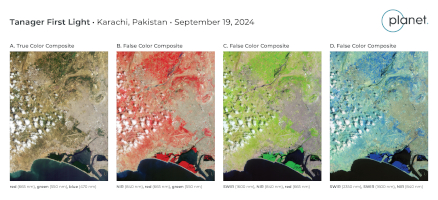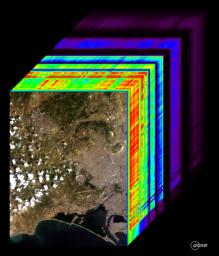An imaging spectrometer designed by NASA's Jet Propulsion Laboratory captured its first data over Karachi, Pakistan, on Sept. 19, 2024. The instrument is aboard the Carbon Mapper Coalition's Tanager-1 satellite, which was built by Planet Labs PBC.
An imaging spectrometer can measure hundreds of wavelengths of light that are reflected by Earth's surface. Different compounds in the planet's atmosphere and on the ground absorb different wavelengths of light, leaving spectral "fingerprints" that researchers can identify. The imaging spectrometer aboard Tanager-1 will enable the satellite to measure methane and carbon dioxide point-source emissions, down to the level of individual facilities and equipment, on a global scale.
The image at the front of the cube shows a mix of information on land cover and water in the city and surrounding area, including exposed soil (brown), vegetation (green), and clouds. The rainbow colors extending through the main part of the cube are the wavelengths of light from corresponding spots in the front image.

Figure A
Click on the image for larger versionThe four images in Figure A are false-color composite images of the same region, each representing a different combination of light wavelengths. The first image shows the area in red, green, and blue. The second image shows it in a near-infrared wavelength, red, and green. The third image shows it in a shortwave-infrared wavelength, a near-infrared wavelength, and red. The fourth image shows it at two shortwave-infrared and one near-infrared wavelength.
This data was captured to ensure the imaging spectrometer is performing as expected. It does not display any observations of methane or carbon dioxide emissions or other environmental indicators.
Tanager-1, which launched on Aug. 16, 2024, was developed as part of a philanthropically funded public-private coalition led by the nonprofit Carbon Mapper. Planet Labs and JPL are both members of the Carbon Mapper Coalition.

 Planetary Data System
Planetary Data System













